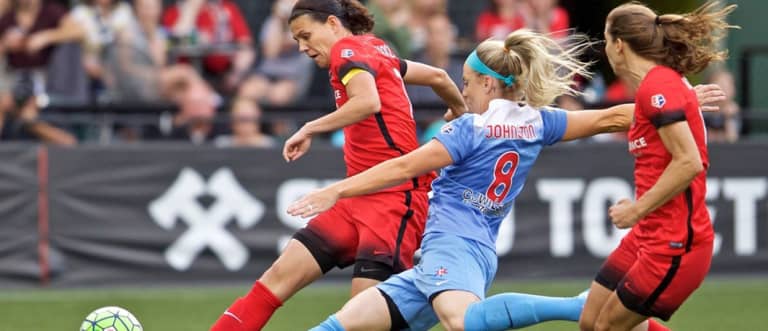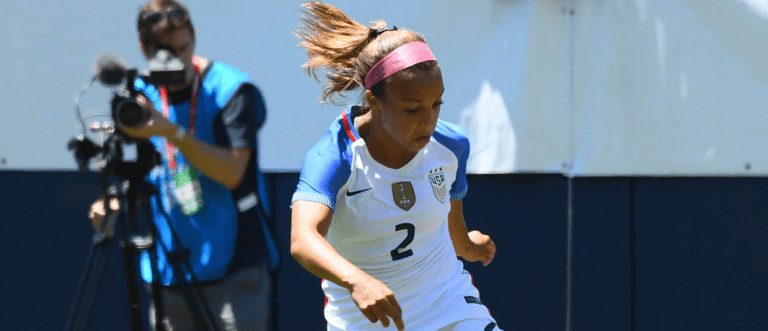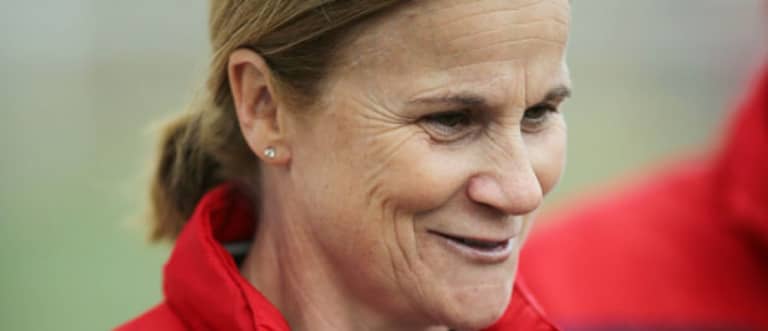The Olympics are over, and for the first time in the 20-year history of the event's women's soccer competition, the US women's national team traveled home empty-handed. Not only did the defending gold medalists miss out on the top prize, which they'd won in four of the five tournaments to date, they missed out on the podium entirely – for the first time ever – thanks to that shocking quarterfinal PK-shootout loss to eventual silver medalists Sweden.
Meanwhile, a deserving Germany took top honors. And the USWNT even found themselves in the unfamiliar position of watching Canada, who they've long regarded as their “little sister” rival to the north, stick around in Brazil a week longer than they did, and repeat as bronze winners. It all added up to a subdued homecoming for the defending World Cup champions as they trickled back to their respective National Women's Soccer League teams to resume club play this week.
Where do the US women – and by extension, the wider women's soccer movement that they headline in the United States – go from here? Here are a few thoughts on the road ahead.

The real heavy lift: promoting NWSL
Since the turn of the century, women's soccer has usually focused on the “Olympic bounce” or “World Cup bounce” at this point after a major tournament, referring to the domestic pro league's efforts to immediately capitalize on the upswing in general interest caused by the USWNT's heroics. After the national team has caught casual observers' attention, the NWSL – or WPS before it, or the WUSA before that – usually sees a spike in attendance numbers, media coverage and the like.
Given the underwhelming circumstances in which the USWNT got drummed out of Rio 2016, we likely won't see too much of a bounce this time around. There won't be delirious player appearances on “Good Morning America” or the nighttime talk-show circuit, or a money-spinning “Victory Tour,” or anything but a fraction of the media penetration that we saw after their World Cup triumph a year ago.
In past years that would've spelled disaster for the revenue streams of cash-strapped club team owners. This time, however, it might actually work out to be a good thing for the sport as a whole.
Under the NWSL's unique structure, the USWNT (as well as their Canadian and Mexican counterparts) are full-time employees of their federation who are “allocated” to their clubs. They're expected to perform at a high level and be the faces of their respective teams, but their paychecks come from US Soccer, not the Chicago Red Stars or the Portland Thorns or the league's other 10 members.
It's a dirty little secret around the league that some of those national teamers consider themselves USWNTers first and NWSLers a distant second. The federation, it should be noted, plays into that perception when it schedules meaningless WNT friendlies right in the middle of the league's stretch run, as it did last year. The national team has already scheduled two exhibition games, on Sept. 15 and 18, but a US Soccer source tells MLSsoccer.com that the WNT will likely play just four more games this year, both expected to fall after the NWSL final on Oct. 9 in Houston.
Now that the USWNT have lost just a bit of their shimmering luster – and won't play important games until World Cup qualifying sometime in 2018 – they will have a chance to focus on the daily slog of competing, improving and growing the sport in their local NWSL communities. And given the huge range in attendance numbers and levels of investment among the young league's member clubs, that's time well spent.

Resolve the CBA
The USWNT's collective-bargaining agreement with the federation expires at the end of the year – and even that simple statement only became clear after a drawn-out legal battle earlier this year, after which a court ruled that the two parties' memorandum of understanding extended their previous deal through 2016. That headed off the possibility of a player strike this year, and absent that leverage, the team shelved CBA talks until after the Olympics.
As you may have seen, the players have mounted an extensive publicity campaign, dubbed “Equal Pay For Equal Play,” to make their case that they are compensated at far lower levels than the USMNT despite being more successful on the field. Falling short of Olympic gold does nothing to help their cause, but a general sense of frustration at years of perceived slights is likely to keep them in a fairly hard-line stance.
The WNT have maintained remarkable focus even amid the CBA uncertainty. But with the end of the year fast approaching, there's really not all that much time left to strike a deal. For better or worse, there are no major upcoming international events on the calendar to add a deadline or sense of urgency to the process, so there's no telling what goes down here, or how it might affect NWSL. But a resolution is needed in order for players and federation to work together efficiently going forward.

Pathway for youth movement
One could easily argue that the WNT's least experienced players were their best performers in these Olympics. Young wingers Crystal Dunn and Mallory Pugh were aggressive and hard-working out wide, scoring a goal apiece and bringing welcome doses of incision for an attack that too often lacked a killer instinct. Morgan Brian, 23, was the steadiest performer of a disappointing central midfield corps and at age 24, center back Julie Johnston looks likely to contribute for many years to come.
But the team's culture has long valued experience and longevity, a big part of why veterans like Carli Lloyd (age 34) and Hope Solo (age 35) are already looking ahead to the next World Cup/Olympic cycle with confidence that they'll take part in France 2019 and Tokyo 2020.
Meshing these two disparate elements looks like coach Jill Ellis' toughest job to come. While still flawed, the youth development process works more efficiently than it did in the past, meaning that many of Pugh's generation are far more advanced than their elders were at this point in their careers. With NWSL formed and operated by the federation for the specific purpose of cultivating a talent pool for the national team, USWNT spots should get tougher to grab and keep with each passing year.
A big question here: When will the likes of Pugh outgrow the NCAA system? Right now women's soccer is where MLS was 20 years ago, before Generation adidas and the Homegrown pathway gave young players a chance to enter a professional environment at earlier ages. There isn't yet enough money in the women's pro game to justify passing on a free education, but that may soon change.
USWNTer Lindsey Horan signed a pro contract with French power Paris Saint-Germain straight out of high school four years ago, and earlier this year Pugh came very close to doing the same with US Soccer and the Portland Thorns. Many insiders are convinced that Pugh, who plans to play at UCLA but deferred her fall enrollment because of WNT and US U-20 commitments, will leave school early to go pro. If she does, it could be a paradigm-changing move.

Commit to USWNT's philosophical path
Over the past year coach Jill Ellis talked at length about the process of evolving her team's playing style to a more sophisticated, proactive approach built on possession and movement, as opposed to the direct, aerial-oriented attacking of the past. They certainly walked the walk during CONCACAF Olympic qualifying last winter, but fell short of their own expectations during the Rio tournament itself.
The loss to Sweden can certainly be considered an outlier, given the overwhelming US dominance in every statistical area save the score that day. Yet in the end, former USWNT coach Pia Sundhage outflanked her former assistant Ellis (and, it must be said, hosts Brazil in the semifinals, too) with organized but limited bunker-and-counter tactics that completely frustrated the US. In retrospect, Sundhage exposed her old team at an awkward period of transition between styles, generations and ideologies.
If Ellis is truly committed to a modern way of play, she now has the ideal opportunity to implement it exactly as she wants over the next two years, with personnel that suit it rather than shoehorned holdovers. She will have an entire league (NWSL) to evaluate and pick in-form players from – and depending on the final look of the WNT CBA, possibly more flexibility with the selection process than at present.
That may well shake up that longstanding locker-room culture. But as the national team learned the hard way in Brazil, women's international soccer is growing and evolving rapidly, and they don't want to get left behind.













